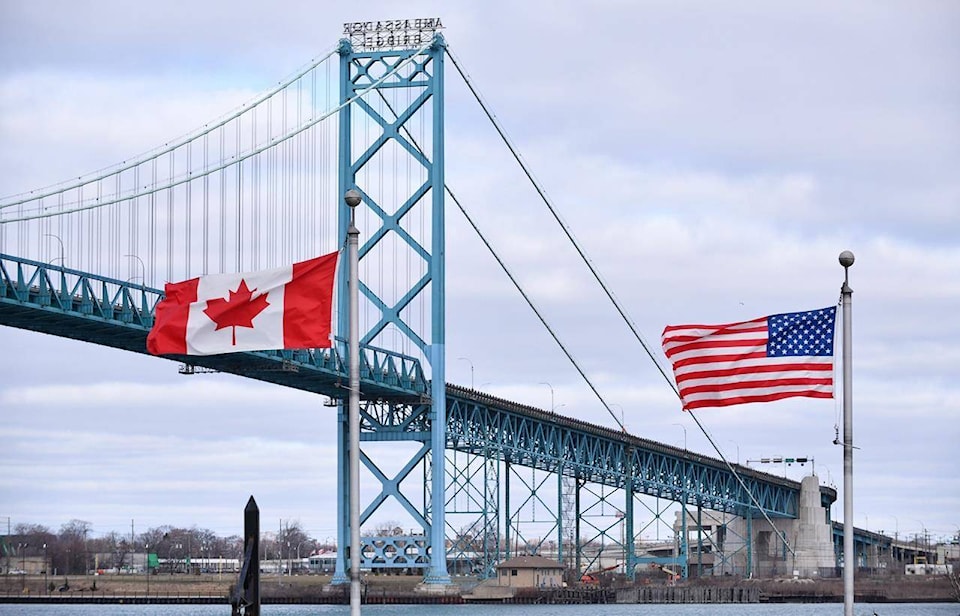WASHINGTON — Canada and the United States are now widely expected to extend their mutual ban on non-essential cross-border travel as COVID-19 destroys President Donald Trump’s hopes for a quick end to America’s public-health nightmare.
The Canada-U.S. border has been closed to “discretionary” travel like vacations and shopping trips since the pandemic took hold of the continent in mid-March, a rolling 30-day agreement that’s currently set to expire July 21.
Officials on both sides of the border who are familiar with the ongoing talks, speaking on condition of anonymity to discuss matters not yet public, say another extension until late August is all but inevitable, thanks to a towering wave of new COVID-19 cases that’s swamping efforts to restore a modicum of normality in the U.S.
New York Rep. Brian Higgins, one of several members of Congress from northern states keen to see a plan for reopening the border, expressed dismay Tuesday at news he called disappointing but hardly surprising.
“With no leadership from President Trump to address the pandemic, cases in the United States are spiking and as a result U.S. citizens are not welcome in several countries around the globe, including many of our allies,” Higgins, a Democrat, said in a statement.
Recent calls from Higgins and others for a plan to start easing border restrictions have been greeted with social-media scorn and derision in Canada, where recent polls make clear the idea of allowing entry to Americans any time soon is a non-starter.
The novel coronavirus has been particularly resurgent in southern states like Florida, Texas, Georgia and Louisiana, where businesses tried to reopen early, contrary to the advice of public health officials, and the wearing of face masks became a partisan issue.
“The U.S. and Canada should be developing a plan that lays out what continued, nuanced management of the border during a prolonged pandemic will look like,” Higgins said.
“But the administration’s failure to develop a national plan for widespread testing, (personal protective equipment) distribution and the rejection of social distancing and mask-wearing to slow the spread doesn’t inspire confidence that such a plan is in the works.”
Wearing a mask, perhaps the simplest way to reduce the spread of the novel coronavirus, has evolved into one of the most complex and flummoxing points of division in the U.S., thanks in part to conflicting signals early in the crisis about its effectiveness and the obvious reluctance of the commander-in-chief to embrace the idea.
It was only just this past weekend — nearly four months into the crisis — that Trump himself was photographed wearing one in public, during a visit with wounded service members at Walter Reed National Military Medical Center.
Dr. Robert Redfield, the director of the Centers for Disease Control and Prevention, urged Americans to mask up Monday, saying facial coverings for everyone in the country would break the pandemic’s back in less than two months.
“It’s our major defence to prevent ourselves from getting this infection,” Redfield told a news conference in Charlotte, N.C. “If all of us would put on a face covering now for the next four weeks, six weeks, I think we could drive this epidemic into the ground.”
Paradoxically, new online polling from Leger and the Association for Canadian Studies suggests the idea of mandatory masking in public is more popular in the U.S. than it is in Canada.
Leger’s latest online poll, conducted July 10 to 12, found 72 per cent of 1,001 American respondents supported the idea of mandatory masks indoors, compared with 67 per cent of the survey’s 1,523 Canadian participants. Of those surveyed in the U.S., 41 per cent said they would consider it a violation of their personal freedoms, compared with 27 per cent of those in Canada.
“Americans are far more likely to agree that rights are at issue,” said ACS president Jack Jedwab. “Yet, despite the fact that Americans strongly agree that the mask requirement is a rights infringement, they nonetheless believe that mask wearing should be mandatory.”
Trump appears to be capitulating on other border issues as well: on Tuesday, facing a lawsuit from Harvard University and the Massachusetts Institute of Technology, the administration abandoned a controversial measure that would have forced international students whose courses move entirely online to either transfer schools or leave the country.
That news likely comes as a relief to untold thousands of Canadian students studying south of the border, many of whom have been forced into virtual classrooms with colleges and universities having cancelled in-person classes.
Dr. Howard Njoo, Canada’s deputy chief public health officer, was reluctant Tuesday to discuss the worsening COVID-19 situation in the U.S. in any detail.
But he said cross-border travel in a public health emergency is usually a matter of ensuring that both countries have a similar grip on the circumstances, taking into account factors like their respective health-care systems, testing and contact-tracing regimes and strategies for preventing transmission.
Given that a number of U.S. states are experiencing community transmission of COVID-19 and don’t have the situation under control, it will likely be weeks or even months before the benefits of additional preventative steps become apparent.
“It will take some time,” Njoo said. “If I were to travel anywhere, I would stick to Canada for the time being.”
